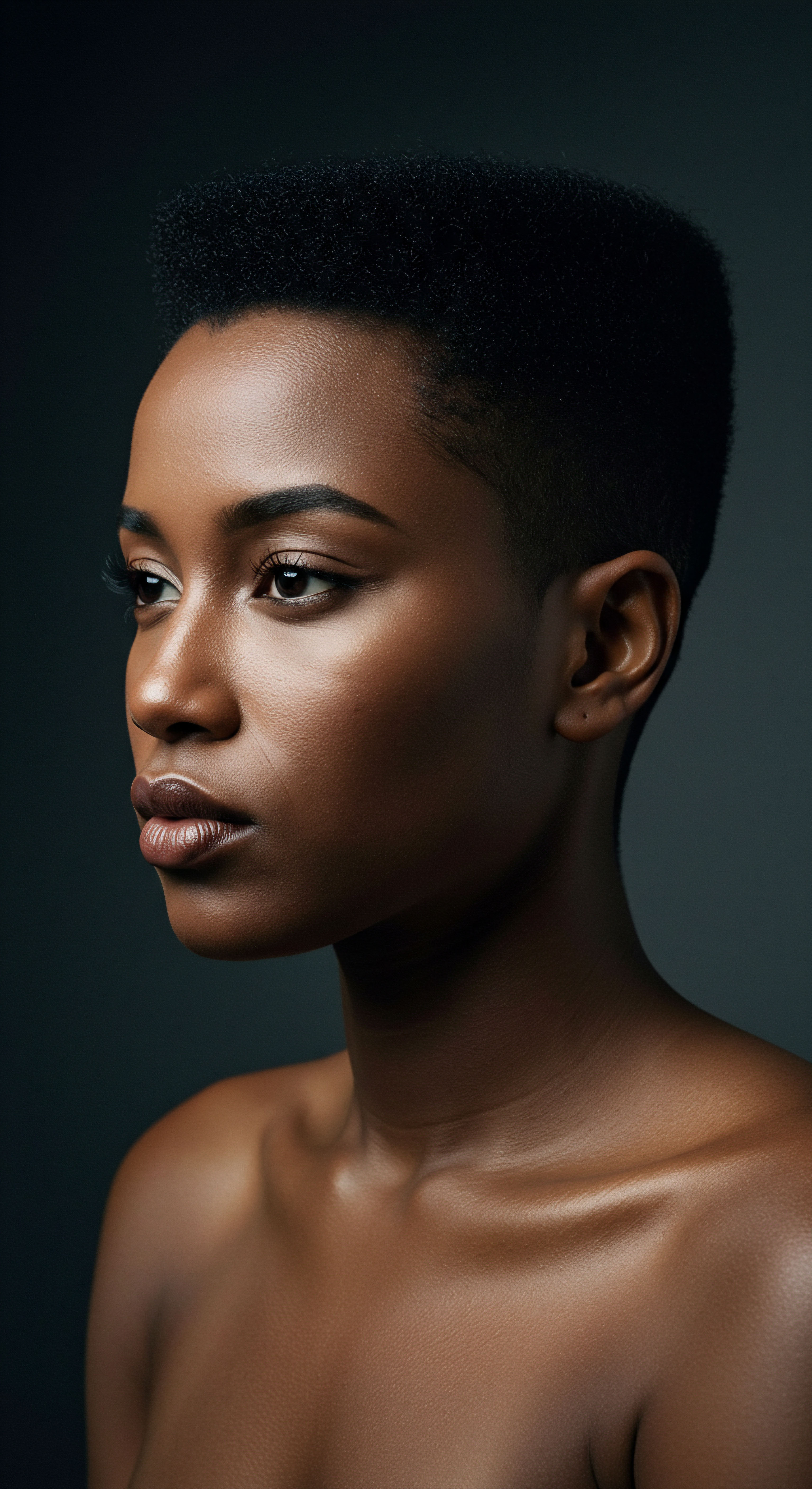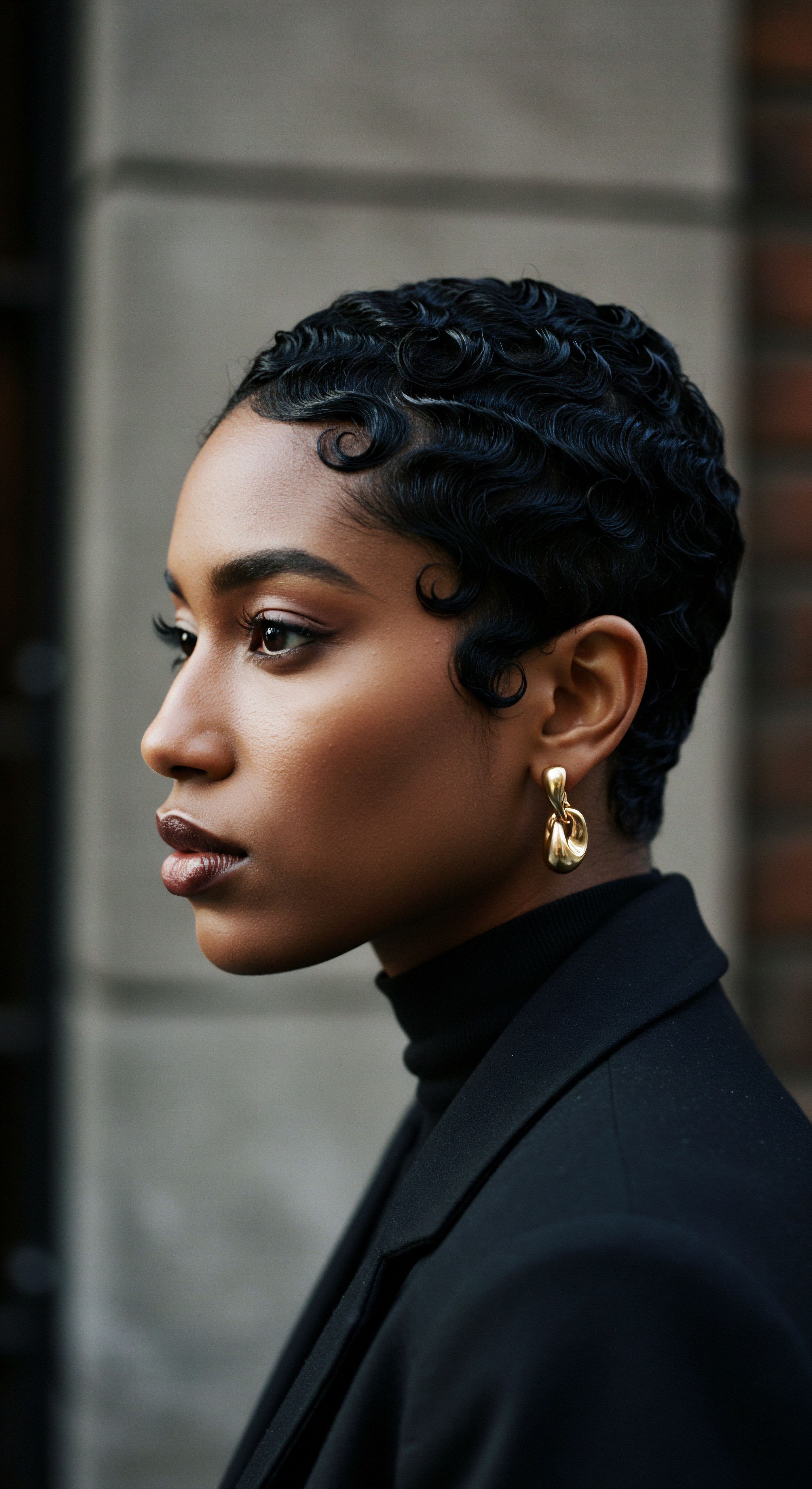
Roots
Beneath the surface of our skin, a quiet, intricate dance unfolds within each hair follicle. It is a rhythmic ballet, choreographed by an internal clock that governs the very life of our strands. This isn’t merely about hair growing or falling; it speaks to a deeper, inherent wisdom residing within our bodies, a biological cadence influencing the very nature of our textured hair. For those with coils, kinks, and waves, this internal timekeeper holds particular resonance, shaping not only the physical manifestation of our hair but also how we interact with it, generation after generation.
Consider the unseen cycles that dictate the growth, rest, and renewal of each strand. The hair follicle, a mini-organ in itself, possesses its own set of timekeeping mechanisms, working in concert with the body’s broader circadian system. This sophisticated biological timing system orchestrates countless cellular processes, from cell division to protein synthesis, all of which are absolutely central to the vitality and appearance of our hair. It’s a silent, constant rhythm, influencing everything from when hair grows fastest to when it might be more susceptible to environmental shifts.

What Governs the Hair Follicle’s Rhythms?
At the heart of this follicular chronometer lie specific molecular components, often called Clock Genes. These genes, including those known as Period (PER), Cryptochrome (CRY), CLOCK, and BMAL1, form a complex feedback loop within the cells of the hair follicle. CLOCK and BMAL1, for instance, act as transcriptional activators, prompting the expression of other genes, including PER and CRY.
These proteins, in turn, suppress the activity of CLOCK and BMAL1, creating a cycle that repeats approximately every 24 hours. This self-regulating system is a testament to the profound organization within our biological architecture.
This internal clock is not entirely isolated. It receives signals from the body’s central circadian pacemaker, located in the brain’s suprachiasmatic nucleus (SCN), which responds to external cues like light and darkness. Yet, the hair follicle also exhibits a degree of autonomy, functioning as a peripheral clock that can integrate local environmental signals and metabolic states. This dual influence means that while our sleep-wake patterns affect our hair, so too can the direct environment of the scalp.
The hair follicle operates on its own internal clock, a rhythmic system influenced by both the body’s central timekeeper and its immediate surroundings.

The Hair Growth Cycle and Daily Oscillations
The hair growth cycle itself unfolds over weeks to months, moving through three primary phases ❉ Anagen (active growth), Catagen (a transitional phase of regression), and Telogen (a resting phase). What is particularly striking is how the daily, 24-hour circadian rhythms within the follicle interact with these longer growth cycles. Research indicates that the expression of clock genes varies across these phases, with heightened activity often observed during the telogen-anagen transition, a crucial period for new growth. This suggests a delicate interplay, where the daily cellular timing helps to orchestrate the broader, regenerative process of hair cycling.
The stem cells within the hair follicle, particularly in the secondary hair germ, exhibit strong circadian rhythmicity. These cells are the architects of new hair, and their timed activation and proliferation are essential for the initiation of the anagen phase. Understanding this foundational layer of biological timing helps us appreciate the sophisticated mechanisms governing our hair’s existence.

Ritual
As we move from the unseen rhythms of the hair follicle’s internal clock to the tangible practices of hair care, a sense of practical wisdom emerges. Our daily and weekly hair rituals, whether conscious or intuitive, often align with subtle shifts in our hair’s receptiveness. Understanding the follicle’s internal timekeeping mechanism can transform our approach, allowing us to move beyond simply applying products to truly working in concert with our hair’s natural inclinations. This section delves into how we might attune our care practices to these inherent rhythms, finding a more gentle, yet effective, path to vibrant textured strands.

Optimizing Care Through Timing
Considering the hair follicle’s daily oscillations, the timing of our care rituals gains a new dimension. For instance, studies have shown that the proliferation of hair matrix cells, which are responsible for hair growth, exhibits a daily rhythm, with some research indicating faster growth in the morning hours. While this daily fluctuation might be subtle in its visible impact, acknowledging it can subtly influence our approach to invigorating treatments.
The concept of “chronotherapy” in hair care, though still an evolving field, suggests that certain interventions might be more effective when timed to specific biological windows. For example, some topical applications or scalp massages might yield enhanced benefits when applied during periods of heightened cellular activity or receptivity. This does not demand rigid adherence to a clock, but rather a mindful consideration of our body’s natural ebb and flow.
Aligning hair care practices with the follicle’s internal rhythms can lead to more responsive and effective routines.

Sleep’s Influence on Hair Vitality
The quality and regularity of our sleep patterns are profoundly linked to the central circadian rhythm, and by extension, to the peripheral clocks in our hair follicles. Disrupted sleep, a common reality in modern life, can lead to widespread physiological imbalances. The hormone Melatonin, known for regulating sleep-wake cycles, also plays a role in hair development. Its production increases during sleep, contributing to cellular repair and regeneration, including protection against oxidative damage within the hair follicle.
Studies have indicated that sleep deprivation can decrease beard-hair growth, possibly due to reduced protein synthesis and lower levels of growth hormone and dihydrotestosterone (DHT) release. Conversely, some research, though requiring further investigation, has even suggested correlations between prolonged sleep and certain types of hair loss. This complex relationship underscores the delicate balance required for optimal hair health, emphasizing that restful sleep is not merely a luxury but a fundamental aspect of hair wellness.
| Care Activity Deep Conditioning Treatments |
| Potential Optimal Timing Evening or before sleep |
| Rationale from Follicle Rhythm Allows ingredients to work during overnight cellular repair processes. |
| Care Activity Scalp Massages |
| Potential Optimal Timing Morning or evening |
| Rationale from Follicle Rhythm Morning for stimulation as cells become active; evening for relaxation and preparation for rest. |
| Care Activity Product Application |
| Potential Optimal Timing Aligned with hair's natural moisture retention peaks |
| Rationale from Follicle Rhythm May enhance absorption and effectiveness when hair is most receptive. |
| Care Activity Protective Styling |
| Potential Optimal Timing Before periods of high activity or environmental exposure |
| Rationale from Follicle Rhythm Shields hair during times when external stressors might be more impactful. |
| Care Activity These suggestions represent potential alignments based on chronobiological principles, encouraging mindful care. |

Seasonal Shedding and the External Clock
Beyond the daily cycle, our hair also responds to seasonal shifts, a phenomenon known as Seasonal Hair Shedding. This cyclical change, often more noticeable in late summer through fall, is believed to be linked to changes in daylight hours and hormonal fluctuations. Research using Google Trends data, for example, has shown a consistent spike in hair loss-related searches peaking in late summer and early autumn across various English-speaking countries. This pattern suggests an evolutionary adaptation, perhaps where humans historically grew more hair in summer for sun protection, shedding it as cooler months approached.
- Anagen ❉ The active growth phase, where hair grows from the follicle.
- Catagen ❉ A brief transitional phase where growth stops and the follicle shrinks.
- Telogen ❉ The resting phase, where the hair remains in the follicle but is no longer growing.
- Exogen ❉ The shedding phase, where old hairs are expelled as new ones begin to grow.
During late summer and fall, a larger proportion of hairs enter the telogen (resting) phase, leading to increased shedding. This highlights how external environmental cues, processed by our internal clocks, translate into observable changes in hair behavior. Recognizing these seasonal rhythms can help temper concerns during periods of increased shedding, framing it as a natural, cyclical occurrence rather than a cause for alarm.

Relay
To truly appreciate the hair follicle’s internal clock, we must delve into its deeper scientific underpinnings and its intricate connections to the body’s broader physiological systems. This exploration moves beyond daily routines to the molecular symphony that orchestrates hair growth, inviting us to consider how disruptions in this delicate timing can reverberate through our hair health. Here, we uncover the precise mechanisms and the wider implications of this biological timekeeping, drawing upon research and data to illuminate its profound significance.

How Do Clock Genes Orchestrate Hair Growth?
The molecular clock within the hair follicle is a complex interplay of specific genes and their protein products. Core clock genes, including BMAL1, CLOCK, PER, and CRY, are not merely present; they are actively expressed in a rhythmic fashion within various cells of the hair follicle, including keratinocytes, fibroblasts, and melanocytes. The CLOCK-BMAL1 heterodimer acts as a positive regulator, initiating the transcription of genes like PER and CRY. In turn, the PER and CRY proteins then suppress the activity of the CLOCK-BMAL1 complex, creating a feedback loop that sustains the approximate 24-hour cycle.
This internal timekeeping system directly influences the hair growth cycle by regulating cell cycle progression. For example, research has shown that these clock genes play a role in the regulation of cell cycle genes. In mice, the absence of BMAL1 has been linked to a significant delay in the anagen (growth) phase of the hair cycle.
This delay occurs because the progenitor cells in the hair germ, which are vital for initiating new hair growth, become arrested in the G1 phase of the cell cycle, a stage where cells prepare for division. This compelling evidence points to a direct regulatory role of the circadian clock in the timing and progression of hair regeneration.
The hair follicle’s internal clock, driven by core clock genes, directly influences hair growth by regulating cell cycle progression.

What Are the Broader Connections of the Hair Follicle Clock?
The hair follicle clock is not an isolated entity; it communicates with and is influenced by systemic factors, underscoring its connection to overall bodily wellness. Hormones, for instance, play a significant role. Thyroid hormones directly alter hair follicle functions, influencing both hair growth and pigmentation.
Patients with thyroid dysfunction often exhibit a disordered circadian clock, suggesting a bidirectional relationship between hormonal balance and the follicle’s timing mechanisms. Estrogens also alter hair follicle growth and cycling, with fluctuating levels during menopausal transition potentially influencing hair shedding patterns.
Beyond hormones, the circadian clock also impacts cellular metabolism and reactive oxygen species (ROS) homeostasis, both of which are central to hair follicle regeneration. Dysregulation of the clock can lead to increased ROS production, which can negatively impact hair health. This highlights how disruptions to our internal rhythms can create a cascade of effects, influencing cellular environments critical for hair vitality.

Environmental Stressors and Circadian Disruption
External factors can profoundly impact the hair follicle’s internal clock. Consider the compelling case of Shift Workers. Individuals who regularly work night shifts experience a chronic disruption to their natural circadian rhythms. This irregular light-dark exposure and altered sleep-wake patterns can directly affect the expression of clock genes like PER1 and BMAL1 in hair follicle cells.
A study on keratinocytes and dermal papilla stem cells from female shift workers found that chronic circadian dysregulation led to a loss of clonogenic potential, suggesting a diminished regenerative capacity in their skin and hair precursor cells. This offers a powerful real-world example of how a misaligned internal clock, driven by external lifestyle demands, can visibly manifest in hair health challenges.
Environmental pollutants, such as particulate matter and UV radiation, also exert influence. UV radiation, for example, can cause oxidative damage and trigger cellular changes within the hair follicle, potentially affecting its rhythmic functions and contributing to hair loss or greying. The body’s response to these stressors, mediated by the internal clock, can determine the resilience of the hair follicle.
| Clock Gene CLOCK |
| Primary Function Transcriptional activator, forms heterodimer with BMAL1. |
| Impact on Hair Follicle Initiates expression of other clock genes, affects anagen progression. |
| Clock Gene BMAL1 |
| Primary Function Transcriptional activator, forms heterodimer with CLOCK. |
| Impact on Hair Follicle Essential for anagen progression, regulates stem cell activity, influences cell cycle genes. |
| Clock Gene PER1/2/3 |
| Primary Function Repressor proteins, inhibit CLOCK-BMAL1 activity. |
| Impact on Hair Follicle Part of the negative feedback loop, affects hair growth cycle duration. |
| Clock Gene CRY1/2 |
| Primary Function Repressor proteins, inhibit CLOCK-BMAL1 activity. |
| Impact on Hair Follicle Contributes to the rhythmic oscillation of the clock, influences hair growth. |
| Clock Gene These genes collectively create the oscillatory mechanism within the hair follicle, influencing its cyclical behavior. |
- Melatonin ❉ A hormone that regulates sleep-wake cycles, also linked to hair development and protection against oxidative damage.
- Thyroid Hormones ❉ Directly affect hair follicle functions, influencing growth and pigmentation, and are connected to circadian clock activity.
- Estrogens ❉ Influence hair growth and cycling, with fluctuating levels potentially impacting shedding patterns.

Reflection
Our journey through the hair follicle’s internal clock reveals a profound truth ❉ our hair, in its intricate dance of growth and rest, is a living testament to the rhythms that govern all life. It whispers of ancient wisdom, echoing the turning of seasons and the daily ebb and flow of light and dark. Recognizing this inherent timekeeping within each strand invites us to a deeper, more reverent connection with our textured hair.
It reminds us that care extends beyond surface treatments, reaching into the very core of our being, harmonizing with the subtle orchestrations of our biological self. May we continue to listen to these quiet rhythms, honoring the wisdom they impart, and nurturing our hair with the understanding it so richly deserves.

References
- Geyfman, M. Kumar, V. Lin, K. K. & Andersen, B. (2013). Local circadian clock gates cell cycle progression of transient amplifying cells during regenerative hair cycling. Proceedings of the National Academy of Sciences, 110(24), 9832-9837.
- Lin, K. K. Kumar, V. Geyfman, M. Chudova, D. Ihler, A. T. Smyth, P. & Andersen, B. (2009). Circadian clock genes contribute to the regulation of hair follicle cycling. PLoS Genetics, 5(7), e1000573.
- Hardman, J. A. Haslam, I. S. Farjo, N. Farjo, B. & Paus, R. (2008). Thyroxine differentially modulates the peripheral clock ❉ Lessons from the human hair follicle. PLoS One, 93(11), 4381-4388.
- Paus, R. & Foitzik, K. (2004). The hair cycle and hair disorders ❉ an update. Journal of Dermatological Science, 34(1), 9-18.
- Akashi, M. Soma, H. Yamamoto, T. & Nishida, E. (2010). Noninvasive method for assessing the human circadian clock using hair follicle cells. Proceedings of the National Academy of Sciences, 107(36), 15944-15949.
- Plikus, S. T. Gay, D. L. Treutlein, B. Antwerp, D. Matranga, C. Seifert, H. S. & Fuchs, E. (2017). Hair follicles as a critical model for monitoring the circadian clock. Cell Stem Cell, 20(3), 329-341.
- Wang, S. & Li, L. (2023). Overview of the Circadian Clock in the Hair Follicle Cycle. International Journal of Molecular Sciences, 24(13), 10839.
- Akashi, M. & Nishida, E. (2010). Hair follicle cells as a model for monitoring the human circadian clock. The FEBS Journal, 277(14), 2873-2882.
- Semenov, Y. R. Hsiang, E. Y. & Aguh, C. (2018). Seasonality of hair loss ❉ a time series analysis of Google Trends data 2004 to 2016. British Journal of Dermatology, 179(3), 770-771.
- Semon, M. J. & Miller, J. A. (2016). Hormones and clocks ❉ do they disrupt the locks? Fluctuating estrogen levels during menopausal transition. Dermatologic Therapy, 29(4), 241-247.
- Piérard, G. E. (2007). The hair eclipse phenomenon ❉ sharpening the focus on the hair cycle chronobiology. Dermatology, 214(1), 1-4.
- Yadav, M. S. Kushwaha, N. & Maurya, N. K. (2025). The Influence of Diet, Lifestyle, and Environmental Factors on Premature Hair Greying ❉ An Evidence-Based Approach. Archives of Clinical and Experimental Pathology, 4(1).